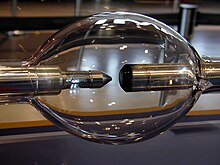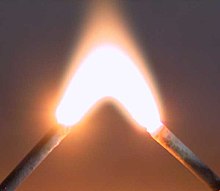Arc lamp
This article includes a list of references, related reading, or external links, but its sources remain unclear because it lacks inline citations. (July 2007) |

An arc lamp or arc light is the general term for a class of lamps that produce light by an electric arc (also called a voltaic arc). The lamp consists of two electrodes typically made of tungsten which are separated by a gas. The type of lamp is often named by the gas contained in the bulb; including neon, argon, xenon, krypton, sodium, metal halide, and mercury. The common fluorescent lamp is actually a low-pressure mercury arc lamp where the inside of the bulb is coated with a light-emitting phosphor. High-intensity discharge lamps operate at a higher current than the fluorescent lamp, and come in many varieties depending on the fill material. Lightning could be thought of as a type of natural arc lamp, or at least a flash lamp.
The electric arc in an arc lamp consists of gas which is initially ionized by a voltage and is therefore electrically conductive. To start an arc lamp, usually a very high voltage is needed to "ignite" or "strike" the arc. This requires an electrical circuit sometimes called an igniter, which is part of a larger circuit called the ballast. The ballast supplies a suitable voltage and current to the lamp as its electrical characteristics change with temperature and time. The ballast is typically designed to maintain safe operating conditions and constant light output over the life of the lamp. The temperature of the arc can reach several thousand degrees Celsius.
Carbon arc lamp
In popular use, the term arc lamp means carbon arc lamp only.
In a carbon arc lamp, the electrodes are carbon rods in free air. To ignite the lamp, the rods are touched together, thus allowing a relatively low voltage to strike the arc. The rods are then slowly drawn apart, and electric current heats and maintains an arc across the gap. The tips of the carbon rods are heated to incandescence, creating light.
==
History


The concept was first demonstrated by Sir Humphry Davy in the early 19th century (1802, 1805, 1807 and 1809 are all mentioned), using charcoal sticks and a 2000-cell battery to create an arc across a 4-inch gap. He mounted his electrodes horizontally and noted that, because of the strong convection flow of air, the arc formed the shape of an arch. He coined the term "arch lamp", which was contracted to "arc lamp" when the devices came into common usage.
There were attempts to produce the lamps commercially after 1850 but the lack of a constant electricity supply thwarted efforts. Thus electrical engineers began focusing on the problem of improving Faraday's dynamo. The concept was improved upon by a number of people including William Staite and Charles F. Brush. It was not until the 1870s that lamps such as the Yablochkov candle were more commonly seen. In 1877, the Franklin Institute conducted a comparative test of dynamo systems. The one developed by Brush performed best, and Brush immediately applied his improved dynamo to arc-lighting. In 1880, he established the Brush Electric Company.
The harsh and brilliant light was found most suitable for public areas, being around 200 times more powerful than contemporary filament lamps. There were three major advances in the 1880s:
- The arcs were enclosed in a small tube to slow the carbon consumption (increasing the life span to around 100 hours).
- Flame arc lamps were introduced where the carbon rods had metal salts (usually magnesium, strontium, barium, or calcium fluorides) added to increase light output and produce different colours.
- František Křižík invented a mechanism to allow the automatic adjustment of the electrodes.
In the US, patent protection of arc-lighting systems and improved dynamos proved difficult and as a result the arc-lighting industry became highly competitive. Brush's principal competition was from the team of Elihu Thomson and Edwin J. Houston. These two had formed the American Electric Company in 1880, but it was soon bought up by Charles A. Coffin, moved to Lynn, Massachusetts, and renamed the Thomson-Houston Electric Company. Thomson remained, though, the principal inventive genius behind the company patenting improvements to the lighting system. Under the leadership of Thomson-Houston's patent attorney, Frederick P. Fish, the company protected its new patent rights. Coffin's management also led the company towards an aggressive policy of buy-outs and mergers with competing manufacturers. Both strategies reduced competition in the electrical lighting manufacturing industry. By 1890, the Thomson-Houston company was the dominant electrical manufacturing company in the US (Noble, 6-10). Nikola Tesla received U.S. Patent 447920, "Method of Operating Arc-Lamps" (March 10, 1891), that describes a 10,000 cycles per second alternator to suppress the disagreeable sound of power-frequency harmonics produced by arc lamps operating on frequencies within the range of human hearing.
Around the turn of the century arc-lighting systems were in decline but nonetheless, Thomson-Houston controlled key patents to urban lighting systems. This control slowed the expansion of incandescent lighting systems being developed by Thomas Edison's Edison General Electric Company. Conversely, Edison's control of direct current distribution and generating machinery patents blocked further expansion of Thomson-Houston. The roadblock to expansion was removed when the two companies merged in 1892 to form the General Electric Company (Noble, 6-10).
Arc lamps were also used in some early motion-picture studios to illuminate interior shooting; one problem was that such lights were so intense that many early film actors and actresses needed to wear sunglasses when not in front of the camera to relieve sore eyes resulting from the extremely brilliant light in the studio. By the dawn of the "talkies", arc lamps had been replaced in film studios with other forms of bright lights.
In 1915, Elmer Ambrose Sperry began manufacturing his invention of a high-intensity carbon arc searchlight. These were used aboard warships of all navies during the 20th century for signals at sea and for illuminating an enemy.[1]
The arc lamps were soon superseded by the more efficient and longer-lasting filament lamps in most roles, remaining in only certain niche markets such as cinema projection and searchlights but even in these applications, conventional carbon arc lamps are finally being pushed into obsolescence by xenon arc lamps.

See also
- Electric light
- Léon Foucault
- Graphite
- František Křižík
- Large Format Slide Projector
- Light bulb
- List of light sources
- Manual metal arc welding
- Movie projector
- Walther Nernst
- Photolithography
- Praseodymium
- Stage lighting
- Timeline of lighting technology
- Tesla patents
- Yablochkov candle
- Pavel Yablochkov
Notes
- ^ Dear, I. C. B. and Kemp, Peter (eds.) (2006) "Sperry, Elmer Ambrose" The Oxford Companion to Ships and the Sea (2nd ed.) Oxford University Press, Oxford, England, ISBN 0-19-20568-X
References
- Braverman, Harry (1974). Labor and Monopoly Capital. New York: Monthly Review Press.
{{cite book}}: Cite has empty unknown parameters:|coauthors=and|month=(help) - MacLaren, Malcolm (1943). The Rise of the Electrical Industry during the Nineteenth Century. Princeton: Princeton University Press.
{{cite book}}: Cite has empty unknown parameters:|coauthors=and|month=(help) - Noble, David F. (1977). America by Design: Science, Technology, and the Rise of Corporate Capitalism. New York: Oxford University Press. pp. 6–10.
{{cite book}}: Cite has empty unknown parameters:|coauthors=and|month=(help) - Prasser, Harold C. (1953). The Electrical Manufacturers. Cambridge: Harvard University Press.
{{cite book}}: Cite has empty unknown parameters:|coauthors=and|month=(help) - Slingo (1900). Electrical Engineering for Electric Light Artisans (Third edition ed.). London: Longmans & Co.
{{cite book}}:|edition=has extra text (help); Cite has empty unknown parameter:|month=(help); Unknown parameter|coauthors=ignored (|author=suggested) (help)
External links
- Arc Lamp - Interactive Java Tutorial National High Magnetic Field Laboratory
